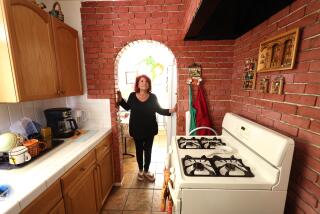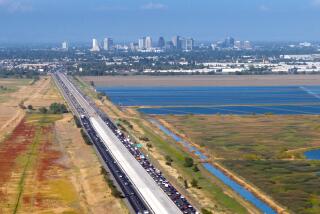School, Residents Plead for Freeway Sound Wall
- Share via
BELLFLOWER — On bad days, when the sun’s glare is particularly ferocious and the noon hour has just passed, the noise is so bad many teachers at St. Bernard Parish School say they just give up.
Those are the days lessons threaten to disintegrate into shouting matches and many teachers and their 305 students finish the day with headaches “even Excedrin will not help,” said fifth-grade student Renee M. DeLint.
The source of their problem is impossible to overlook. Across the street from St. Bernard Catholic Church, the Artesia (91) Freeway, with its eight lanes of traffic, looms above the steeple and sits directly across from the second-story classrooms of the school.
Since the freeway was built more than 20 years ago, the school and the houses to the east and west have been inundated with noise.
Just about everyone along a one-mile stretch of the Artesia Freeway between Clark Avenue and Bellflower Boulevard has had enough.
“To be here, day after day, with this noise is ridiculous,” Principal Gerald Gaudy said.
On Friday, St. Bernard students and nearby residents will present about 2,000 letters to city officials, state legislators and Caltrans officials they have invited to the school to hear their pleas for a sound wall.
The campaign is headed by Melissa Mosley, a parent and part-time teacher at St. Bernard.
Mosley said she realized how bad the problem was in February when she introduced herself to the classroom with the door open and no one heard her. Once the classroom door was shut, Mosley found she could teach her lessons without raising her voice, unless she turned on the air conditioner, which rattled and wheezed so loudly that she turned it off, opting to sweat out an afternoon with 36 students.
“An air conditioner is great, but when it’s a nice day we like to open the door for fresh air and we can’t do that and teach,” second-grade teacher Suzette Goul said.
Nothing short of a portable public address system or whistle helps when the students are out on the playground during recess and lunch, teachers say.
The problem does not stay at the school once the final bell rings. Teachers say their hearing has been affected; when they go home they continue to speak in unnecessarily loud voices. Students say their parents get mad at them for not paying attention when they genuinely did not hear them.
Most residents of the area have been around since the freeway was completed in 1968 and have had 20 years to become immune to the din of traffic. Still, these residents say there is no reason children should be working and playing in a noisy environment all day.
“School is a loud and busy place and they are supposed to be studying,” said Helen Oglivie, who lives down the block from St. Bernard. “They don’t need anything else to distract them.”
Caltrans sound wall project engineer Bill Minter says the answer to the school’s troubles lies with the residents of the area around the school. According to Caltrans regulations, schools near freeways with high noise levels are not eligible for sound walls, only sound proofing and air conditioning, unless it is cheaper for Caltrans to build a sound wall. At an average of $200 per foot for a sound wall, it is more economical to soundproof most schools, Minter said. Before Caltrans engineers will go in and soundproof, however, noise inside the classroom has to be measured at 52 decibels or higher. The last test done at St. Bernard, in 1984, showed a reading of 48 decibels.
But, Minter said, residents who lived in the neighborhood before the freeway was built are automatically eligible for sound walls. Minter said Caltrans uses a sound test and mathematical formula to determine whether a sound wall will reduce the noise. If approved, the wall project is placed on a statewide priority list.
Caltrans did approve a sound wall for the area between Lakewood Boulevard and Woodruff Avenue about seven years ago, Minter said. Under that project, the school would be automatically covered, he said.
Still, it is a distant hope. Right now that sound wall project is ranked 135th on the statewide priority list of more than 200 projects, Minter said. At best, he said, it will be 10 years before a sound wall is built along that stretch of the 91 Freeway.
“Still, I consider them fortunate,” Minter said. “At least they have the residential program coming around. If they didn’t, the school would be left completely undefended.”
Minter said the city could build a sound wall on its own and be reimbursed by Caltrans when the money becomes available. But it would cost an estimated $4 million to build sound walls on both sides of the freeway from Lakewood Boulevard to Woodruff Avenue, which is more than the city can afford, Mayor Pro Tem Randy Bomgaars said.
“It would wipe us out totally,” Bomgaars said.
Minter said Caltrans would be willing to modify the project to reduce costs if the city decided to go ahead and build.
But sound is not the only problem. School officials and students are also wondering about all those carbon monoxide fumes spewing from cars, trucks and buses on the freeway.
“They are living with this now without knowing what is going to happen to them in five or 10 years,” Goul said.
A sound wall will not abate air pollution, Minter said. As far as noise pollution and related problems, Minter said he is not aware of any imminent danger.
“It’s OK to be concerned, but I don’t think we’ve reached those levels of health problems,” he said. “We are not doctors and we have not been informed that the children are at risk. If they were, we would do something about it.”
There is one other hope for a quicker resolution to the problem, Minter said. If a constitutional amendment which includes a 5-cent gasoline tax is passed in June, 1990, it would generate $150 million specifically for sound walls. In that case, St. Bernard Parish School and nearby residents could have a wall earlier than the estimated 10 years.
Mosley still is not satisfied. “It’s everybody’s problem, no one is addressing it, and the kids are the ones that are getting hurt,” she said.
More to Read
Sign up for Essential California
The most important California stories and recommendations in your inbox every morning.
You may occasionally receive promotional content from the Los Angeles Times.













